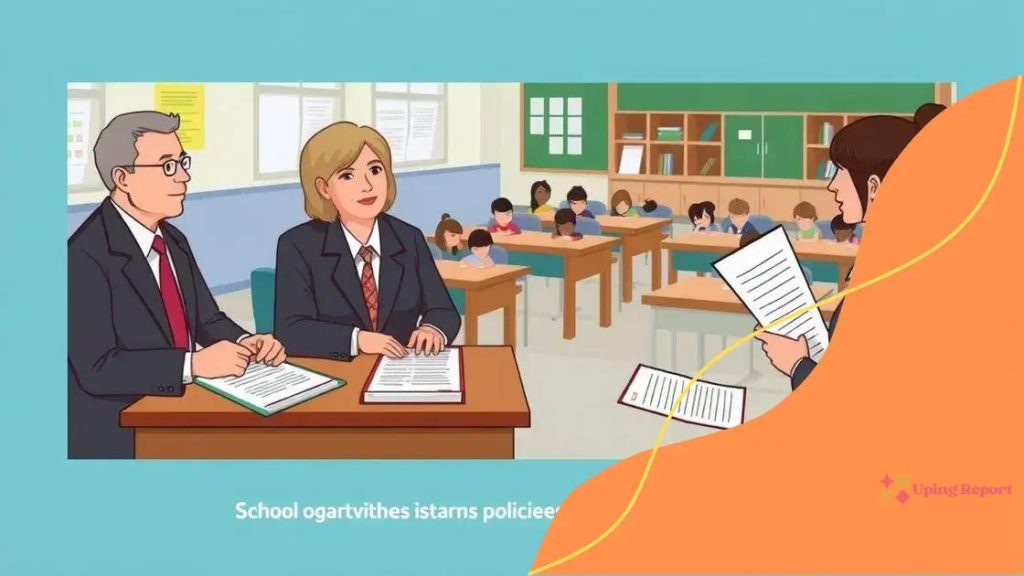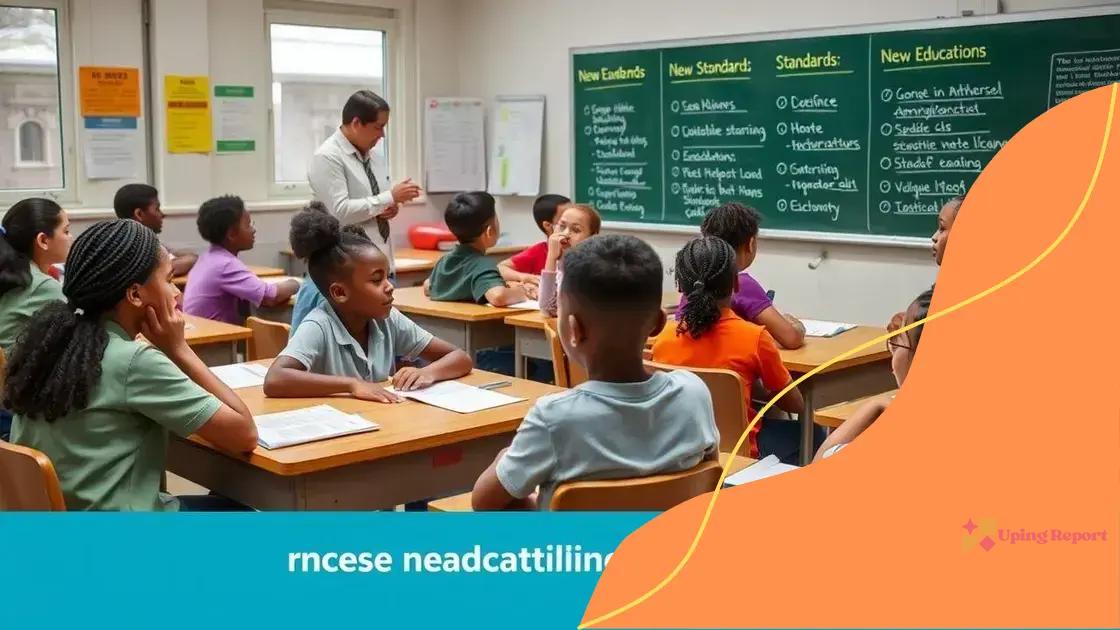Executive orders on education policy: what you need to know

Executive orders on education policy shape funding, curriculum standards, and educational practices, ensuring equity and integration of technology while addressing the mental health needs of students.
From reforms to funding changes, executive orders on education policy play a crucial role in shaping our educational landscape. Have you ever wondered how these decisions affect schools and students nationwide? Let’s dive into the details!
Understanding executive orders in education
Understanding executive orders in education is vital for grasping how policies shape the learning environment. These orders can influence various aspects of the education system, including funding, curriculum standards, and administrative procedures. With a few key examples, we can see how they work in practice.
What Are Executive Orders?
Executive orders are directives issued by the President of the United States to manage the operations of the federal government. In the context of education, these orders can establish significant changes in how educational institutions operate.
Significant Executive Orders in Education
Some landmark executive orders have reshaped the education landscape:
- Brown v. Board of Education: This landmark decision ended racial segregation in public schools.
- No Child Left Behind: Aimed at increasing accountability in education, emphasizing standardized testing.
- Every Student Succeeds Act: Replaced No Child Left Behind, providing states more autonomy in education.
The impact of these actions can be seen clearly in schools across the nation. For instance, when the federal government introduces new funding initiatives through executive orders, it can lead to increased resources for underserved communities. This provides opportunities for all students to succeed.
Furthermore, executive orders also face challenges. Some orders may provoke controversy, especially when they significantly alter existing practices. The debate over these orders often highlights the struggle between federal and local control over education.
Moving forward, understanding how executive orders influence education policy helps stakeholders engage effectively. Teachers, parents, and policymakers must stay informed about potential changes that may arise. By doing so, they can better support educational initiatives and ensure that every child’s needs are met.
Historical context and key milestones
The historical context of executive orders in education reveals how the landscape has evolved. Key milestones in this journey show significant shifts in policies that have shaped the current educational framework.
Early Influence of Executive Orders
In the 1960s, executive orders began to play a crucial role in addressing educational inequality. Initiatives aimed at desegregation set a precedent for federal intervention in local educational issues. Numerous struggles led to impactful changes in public schools, ensuring equal access.
Major Legislative Changes
Over the years, several legislative actions affected education:
- G.I. Bill of Rights: Provided benefits for veterans, including funding for education.
- Elementary and Secondary Education Act: Focused on equal access to education for disadvantaged children.
- Higher Education Act: Expanded federal assistance for post-secondary education.
As education needs grew, executive orders addressed challenges in access, funding, and quality. For instance, the 1974 amendment to the Elementary and Secondary Education Act improved federal funding for schools in low-income areas.
In more recent decades, executive orders have continued influencing public education. The push for standardized testing and accountability emerged in the 2000s, with the No Child Left Behind Act marking a pivotal moment in assessing educational success. This act enforced testing requirements and aimed to bridge achievement gaps across different demographics.
Moving forward, understanding these historical milestones reveals the complex relationship between federal actions and local educational practices. These foundational steps shape our current education system and influence future reforms.
Impact on state and local education policies

The impact of executive orders on state and local education policies is profound. These orders can redefine how schools operate, influencing everything from funding to curriculum standards.
Influencing Education Funding
Executive orders can directly affect funding strategies for schools. When the federal government issues orders focusing on financial support, states must adjust their budgets accordingly. This often leads to enhanced resources in areas like:
- Teacher salaries: Increased funding can allow for better compensation for educators.
- Classroom materials: More resources enable schools to provide updated textbooks and technology.
- Special education programs: Enhanced funding can improve support for students with disabilities.
These financial adjustments help to level the playing field for students across different regions. Schools in lower-income areas benefit greatly from federal initiatives.
Curriculum and Standards
Moreover, executive orders can set new expectations for what students learn. By establishing curriculum guidelines, these orders influence educational standards. For example, previous executive orders have:
- Promoted STEM education: Policies encouraging science, technology, engineering, and math can help prepare students for future careers.
- Incorporated social justice issues: Many orders focus on teaching about diversity and inclusion in schools.
- Standardized testing requirements: These orders can introduce new assessment methods to evaluate student performance.
The collaboration between federal, state, and local governments is crucial in implementing these changes. Schools must adapt quickly to shifts in policy to ensure they meet new standards. This creates challenges but also opportunities for improvement in educational quality.
Engaging teachers and communities in these processes is essential. It allows for a tailored approach that considers local needs while adhering to federal guidelines. The result is a more equitable education system that can respond effectively to diverse student populations.
Challenges and controversies in implementation
Challenges and controversies in implementing executive orders related to education can create significant obstacles for schools and communities. When new policies are introduced, the reactions can vary, leading to debates and misunderstandings.
Common Implementation Challenges
One major challenge is ensuring that state and local education authorities interpret and apply these orders consistently. Different regions may have varying resources, which can affect how well these orders are executed. For example, funding disparities can limit the ability of some schools to meet new standards, resulting in unequal educational opportunities.
Controversial Areas of Policy
Several areas often spark controversy when implementing executive orders:
- Standardized testing: Many stakeholders argue that high-stakes testing places undue pressure on students and doesn’t accurately measure their learning.
- Curriculum changes: Orders that mandate new curriculums can face pushback from educators who feel unprepared or unsupported during the transition.
- Equity issues: There is ongoing debate about how effectively these orders address the needs of marginalized student populations.
These controversies can lead to protests, discussions, and a reevaluation of policies by education stakeholders. Educators and parents often express valid concerns about the direction of educational reform. For instance, executive orders emphasizing accountability may inadvertently lead schools to prioritize test scores over holistic education.
Additionally, communication is vital in mitigating misunderstandings. State and local officials must ensure that changes proposed by executive orders are clearly articulated to those affected. Clear guidance helps prevent resistance and fosters a more collaborative approach to educational reform.
Ultimately, navigating the challenges and controversies of implementing executive orders requires ongoing dialogue among all stakeholders. This includes educators, policymakers, and community members, all of whom play a crucial role in shaping the educational landscape.
Future trends in education through executive orders
Understanding future trends in education through executive orders offers insights into the direction education policy may take. As society evolves, so do the demands placed on the education system.
Technological Integration
One major trend is the increasing integration of technology in classrooms. Executive orders may promote the use of digital tools and resources to facilitate learning. For example, initiatives that encourage schools to adopt online learning platforms can help to reach more students effectively.
Focus on Mental Health and Wellbeing
Another important trend involves placing greater emphasis on mental health and well-being in educational settings. Executive orders may prioritize funding for mental health resources, ensuring students have access to counselors and support services. This response is essential as mental health issues among students continue to rise.
Equity and Inclusion
Executive orders are likely to focus more on equity and inclusion within education. Policies encouraging culturally relevant curricula and inclusive practices can create environments where all students feel valued. These initiatives aim to address systemic barriers that marginalized groups face.
Moreover, there may be a push for increased access to advanced coursework and extracurricular activities for underrepresented communities. This shift can widen opportunities for students who traditionally lacked access.
Collaboration among federal, state, and local entities will be critical in implementing these trends effectively. Educational stakeholders must work together to adapt to these changes while keeping the needs of students at the forefront. The dialogue between policymakers, educators, and families will play a crucial role in future developments.
As new executive orders emerge, staying informed about their impacts will be essential for educators and communities. This awareness will help them navigate the complexities of change and enhance educational quality.
Conclusion: The future of education is shaped by executive orders that bring significant changes to our schools. As policies evolve, important trends like technology integration, mental health support, and a focus on equity will define new learning environments. Collaboration among educators, policymakers, and communities will be essential in embracing these changes and ensuring every student has the opportunity to succeed. Staying informed and engaged is key to navigating the complexities of the educational landscape as we move forward.
FAQ – Frequently Asked Questions about Executive Orders on Education
What are executive orders in education?
Executive orders in education are directives issued by the President that influence policies affecting schools, funding, and student learning.
How do executive orders impact local school policies?
They set guidelines and expectations that local schools must follow, often influencing curriculum, funding, and resource allocation.
What are some recent trends related to executive orders in education?
Recent trends include a focus on technology integration, mental health resources, and promoting equity in educational opportunities.
Why are these changes important for students?
These changes aim to create a more equitable and supportive educational environment, ensuring all students have the opportunity to succeed.
